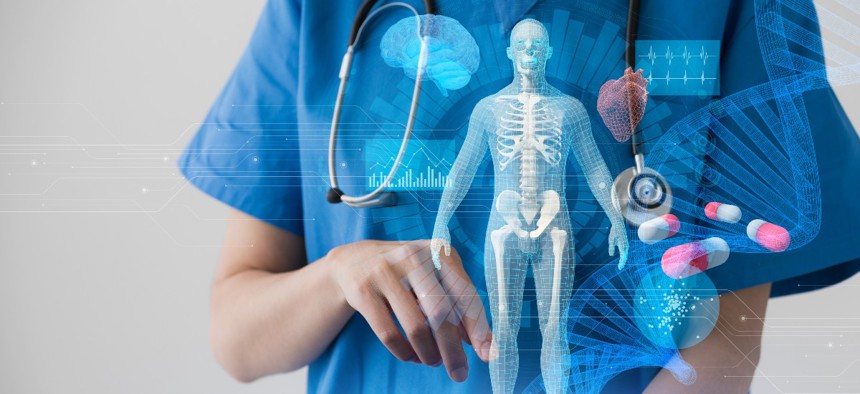Adoption of AI in Health Care Relies on Building Trust, DOD, VA Officials Say

metamorworks/Getty Images
Wider use of health-related artificial intelligence applications at the departments of Veterans Affairs and Defense depends on technologies being “sufficiently understandable.”
Health agencies within the Department of Veterans Affairs and the Defense Department are using artificial intelligence to streamline medical care for active-duty military personnel and veterans, but they must be deliberate in their efforts to build trust in the underlying technologies and algorithms, federal officials said during the General Dynamics Information Technology’s Emerge Health 2022 event on Thursday.
During a panel discussion on health data and AI, Maj. Scott McKeithen—product manager for health analytics within the DOD’s Chief Digital and Artificial Intelligence Office—and Dr. Rafael Fricks—the VA’s associate director for AI in medical imaging—discussed the possibility for AI technologies and machine learning to vastly improve patient outcomes, but also stressed the need to present new innovations in ways that can lead to broader adoption of AI technologies moving forward.
McKeithen said that being able to easily explain this type of technology to health care providers is a critical part of spurring on wider use of AI-based medical innovations.
“It’s important, because they’re extremely smart in what they do, but what they don’t understand is the full technology on the back end,” McKeithen said. “So the ability to be able to explain how your algorithm works, how you’re pulling this information and how you’re able to present that in a way that they can trust it and be able to actually utilize it is important.”
McKeithen added that he hopes that careful adoption and collaboration with health care providers and patients about these new technologies will lead to an outcome similar to people’s trust in using Google Maps for directions, “because it’s been in our lives for a while.”
Successful AI use cases, Fricks said, can also increase funding for additional AI technologies and new hardware. The VA takes roughly 1 billion medical scans each year, Fricks said, citing ongoing efforts within the department to provide health care providers with easier access to patients’ medical scans by training deep learning algorithms and accessing specialized hardware to streamline the process.
“In order to justify the several million dollars it might take to improve the connection between these cyber assistants, we have to show different use cases,” Fricks added. “Artificial intelligence might help us triage different patients, to find secondary findings and really get value out of the data that we’ve already collected.”
Fricks pointed to former President Donald Trump’s December 2020 executive order on promoting the use of trustworthy AI in the federal government, which included a stipulation that agencies’ AI applications “are sufficiently understandable.” The VA subsequently adopted its own departmentwide AI Strategy in September 2021, which also included increasing “veteran and stakeholder trust in AI” as one its four strategic objectives.
“We can promote adoption by having the solution be explainable, at least to the level of the competency of the person that’s expected to use or benefit from this technology,” Fricks said.
As an example of the potential of AI to enhance the DOD’s mission, McKeithen cited the Chief Digital and Artificial Intelligence Office’s work with U.S. Army Medical Command to “bring in predictive analytics, as well as natural language processing and robotic process automation” when reviewing the medical records of military recruits.
“The amount of time it takes a provider or staff to actually scrub those records, to actually determine if an individual has a medical condition that makes them unfit for service based on the DOD’s requirements, is extremely time consuming,” McKeithen said. “So it’s bringing the efficiency to the provider level or to the clinician level, by using robotic process automation, using natural language processing to pull off that information from the scanned images, as well as having a scraping capability or building an algorithm around factors to draw a prediction on the likelihood that an individual has X, Y or Z.”






